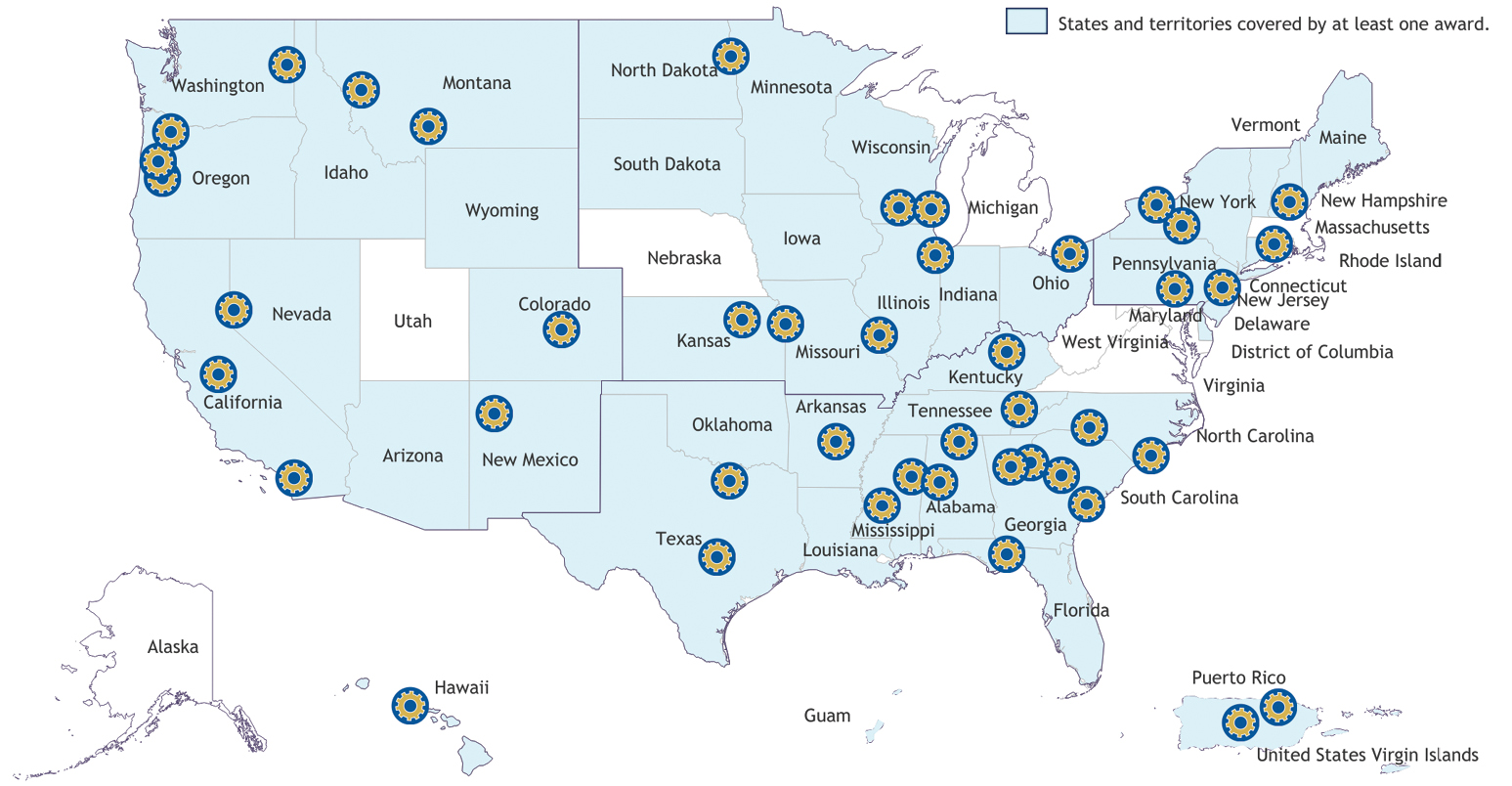The Brookings Institution’s Martha Ross and Mark Muro in January 2024 examined “How federal, state, and local leaders can leverage the CHIPS and Science Act as a landmark workforce opportunity.” Their comprehensive breakdown is worth a close read by business leaders too. By special arrangement, we present here an adapted excerpt of their report. For the complete findings, visit www.brookings.edu/articles/how-federal-state-and-local-leaders-can-leverage-the-chips-and-science-act-as-a-landmark-workforce-opportunity/. — Ed.
The national security establishment knows last year’s $250 billion CHIPS and Science Act mostly for its bold subsidies to encourage firms to build new semiconductor plants and thus compete with China on industrial strategy. Researchers and technology leaders, meanwhile, regard the legislation as the nation’s most significant innovation bill in decades, given its authorization of higher spending targets for the nation’s innovation ecosystem.
And yet, for all that, the law is something else as well, albeit underappreciated for it. Specifically, the CHIPS and Science Act is also a major workforce law. In this respect, the act remains under-recognized not just for its focus on higher-level STEM education, but also as a source of programs and resources for training the nation’s skilled technical workers without bachelor’s degrees — a workforce of great importance as the nation seeks to expand its high-value industrial base.
The Breakdown
The CHIPS and Science Act directs the investment of roughly $250 billion over the next 10 years to build up U.S. semiconductor manufacturing and more broadly support advanced manufacturing, R&D, innovation and workforce development. More specifically, the law encompasses two components. Division A, also known as “the CHIPS Act of 2022,” focuses squarely on strengthening the semiconductor industry—particularly, manufacturing, R&D and workforce development. Altogether, Division A appropriates more than $50 billion in federal spending, including what may be the law’s highest-profile provision: the CHIPS Incentives Program, which provides $39 billion in incentives to build, expand, or modernize semiconductor facilities and equipment. Some $200 million in appropriated resources are allotted here for a Workforce and Training Fund. Division B, “Research and Innovation,” authorizes considerably more spending (about $170 billion) to support progress on broader national goals related to science, technology, commercialization and manufacturing.

In May 2023, the NSF awarded the first-ever NSF Engines Development Awards to 44 unique teams spanning 46 U.S. states and territories.
The CHIPS and Science Act holds out numerous and sizable opportunities for states, metro areas, and other actors to fund STEM and technician workforce development initiatives. In fact, it’s fair to say that the act likely amounts to the main event for funding such efforts in the U.S. for the next few years. The law authorizes the NSF alone to spend $13 billion for STEM education and workforce development over the next five years, or about $2.6 billion per year. By comparison, the formula funding streams supporting training and employment activities for youth, adults, and dislocated workers in Title 1 of the Workforce Innovation and Opportunity Act (WIOA) totaled $3.2 billion in FY 2022 — and only a fraction of that goes directly to training. In other words, the act’s workforce resources are on par in many areas with those in the established workforce development system.
33 Programs Support STEM-related Education, Training and Outreach
The 33 CHIPS and Science Act programs supporting STEM-related education, training and outreach vary in scope and focus. Stand-alone education and training programs total $2.8 billion in authorized spending. Other programs incorporate workforce development into broader goals and total much larger sums, although the amount allocated to education and training is unknown and will probably be a fairly small share.
Nonetheless, the numbers involved are so large that even a small share of a budget line can be a sizable dollar figure. For example, the law authorizes $53 billion toward semiconductor-focused programs as well as $33 billion toward programs supporting innovation and manufacturing, and programs in both categories incorporate workforce development elements.
Among the programs supported by the $33 billion, the newly authorized Directorate for Technology, Innovation and Partnerships (TIP) within the NSF received $20 billion. One of TIP’s flagship efforts will be the Regional Innovation Engines program, authorized at $3.3 billion.
Within the Department of Commerce, the Regional Technology and Innovation Hubs (Tech Hubs) program — authorized at $10 billion and appropriated at $500 million — prominently incorporates workforce development into its goal of developing globally competitive technology and innovation hubs.
As of August 2023, the CHIPS for America program had received more than 450 statements of interest from companies across 42 states seeking incentives to invest in semiconductor facilities. For its part, the NSF has already awarded Regional Innovation Engines planning grants to 44 regional coalitions across the country and is now considering 16 coalitions as finalists — representing places such as Fargo, North Dakota; Lexington, Kentucky; Albuquerque, New Mexico.; El Paso, Texas; East Lansing, Michigan; and Kissimmee, Florida. The funding announcement noted the NSF’s particular interest in regions without well-established innovation ecosystems, suggesting they are hoping to invest in places other than superstar metro areas such as Seattle, San Jose and Boston.
Regarding the Tech Hubs program, the act calls for “geographic diversity and representation” in awards, specifying that at least one-third of the grants should “significantly benefit a small and rural community” and at least two-thirds should benefit “underserved communities in and near metropolitan areas.” The Commerce Department recently designated 31 regions as Tech Hubs and awarded strategy development awards to consortia in another 18 areas. Designated places include Tulsa, Oklahoma; Kansas City, Missouri; Baltimore, Maryland; Birmingham, Alabama; Baton Rouge, Louisiana; and Reno, Nevada.
Twenty legislative provisions support STEM education and workforce development as a goal in itself. They include programs for K-12, undergraduate (including community college) and graduate students as well as internships, fellowships and informal learning activities. A handful focus on specific technologies, such as quantum networking, cybersecurity, clean energy and nuclear technology.
Another Department of Commerce program — the Distressed Area Recompete Pilot Program — targets persistently economically distressed communities to create and connect people to good jobs. It targets communities with below-average employment rates for people of prime working age (25 to 54). Commerce received more than 560 applications in response to a June 2023 Notice of Funding Opportunity, and in December, the agency designated 22 finalists and awarded 24 strategy development grants.
Private Sector Leadership
The Tech Hubs and Regional Innovation Engines programs require awardees to fully integrate technology development and workforce efforts. Meanwhile, the semiconductor incentives program takes a new approach to supporting workforce development by giving private sector actors decision-making authority over funding decisions and encouraging state and local governments to make matching investments in education and training.
This approach is a promising model that marks a break from “train and pray” scenarios in which workforce investment decisions remain divorced from job placement and hiring activities. Instead, the companies receiving the CHIPS and Science Act’s manufacturing subsidies will determine how to support related workforce development efforts — a direct application of the principle that workforce development should be driven by employer demand.
Of course, employers won’t be able to do it alone. They will need to partner with area organizations such as community colleges, workforce development boards, apprenticeship programs, unions, nonprofit training providers, and others. What’s more, the funding opportunity for manufacturing incentives for commercial fabrication facilities explicitly prioritizes applications that include state and local incentives benefiting regional semiconductor ecosystems, not just one firm. Rather than only tax breaks for companies, the CHIPS office is looking for incentives such as workforce and education investments. Several states have already announced investments in semiconductor-related education and training, including Minnesota, Michigan, Arizona, New York and Ohio.
The CHIPS and Science Act stands out not just as an international security, technology, or innovation strategy landmark, but as a watershed in U.S. workforce development. Once-in-a-generation funding levels have at last been authorized to support STEM-related workforce education and training. At the same time, the new industrial policy package integrates progressive workforce development concepts, such as a strong focus on non-college training, experiential learning, and stackable credentials. As such, the act stands out as a milestone for advancing a modern pairing of industry development and workforce training.
Yet for all this promise, the CHIPS and Science Act remains an imperfect work-in-progress — the success of which will depend on sustained follow-through in such areas as funding and coordination by major employers as well as organizations such as state workforce development boards.
The CHIPS and Science Act’s vision of a reinvented STEM and technical workforce system depends heavily not just on the coordination of federal agencies and programs, but also on effective collaboration among key state and regional stakeholders, as well as the private sector. In short, the success of Congress’ compelling workforce strategy hinges on interagency links and sub-national implementors.
Private Sector Plays Big Role in Getting Cyber-Focused

Martha Ross, Senior Fellow, Brookings Metro
“The field of cybersecurity may offer some lessons in developing and executing a workforce strategy for specific technological fields,” write the Brookings Institution’s Martha Ross and Mark Muro, noting the July 2023 release by the White House of the National Cyber Workforce and Education Strategy (NCWES). Among the reasons cyber stands as a model is its plethora of stakeholders that have already demonstrated their commitment to the NCWES through their actions and partnerships, said the White House. As this excerpt from the announcement notes, a number of private-sector organizations have stepped up:
Check Point Software Technologies committed to training 1 million individuals in cybersecurity skills by 2028 through its MIND Cyber Security Training Program, which offers free training kits to all educational organizations in the United States.
Microsoft and Black Tech Street have announced an unprecedented long-term alliance for Historic Greenwood, the neighborhood in Tulsa, Oklahoma, given the moniker “Black Wall Street” by Booker T. Washington. Dubbed “The Digital Transformation of Black Wall Street to Black Tech Street,” the alliance aims to restore Greenwood’s position as a national hub for Black talent and innovation with an initial focus on cyber. Microsoft also is partnering with Last Mile Education Fund, Whatcom Community College (in the State of Washington) and the American Association of Community Colleges to achieve its goal of helping skill and recruit into the cybersecurity workforce 250,000 people by 2025. To date, this effort has supported over 379 community colleges in 48 out of 50 states.
In collaboration with the Consortium of Cybersecurity Clinics, Google.org has committed more than $20 million to support the creation and expansion of cybersecurity clinics at 20 higher education institutions following the launch of the Google Cybersecurity Certificate program.
Mastercard will further its support of equipping American girls with foundational cyber skills through its commitment to educate 5 million students by 2025 with its flagship STEM education program, Girls4Tech™. Mastercard will also support access to free cybersecurity education, trainings, and resources for up to 10 million micro, small and medium businesses by 2025.
Lightcast will provide quarterly data announcements on the size of the cyber talent needs, providing a more comprehensive, up-to-date picture of the cyber labor market. In addition, Lightcast will develop a skills-based hiring toolkit for employers to help companies implement best practices in developing their cyber workforce.
CrowdStrike will fill 300+ internship positions, fund 10 $10,000 scholarships, expand upon its successful SkillBridge apprenticeship program and continue to offer its “return-to-work” program focused on caregivers by Q1 2025.
SAP will further its commitment to help close the cybersecurity skills gap by expanding its two-year Global Security Early Talent program. This builds on SAP’s digital skills initiative goal to upskill 2 million learners worldwide with technology skills by the end of 2025.
